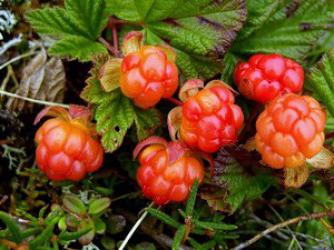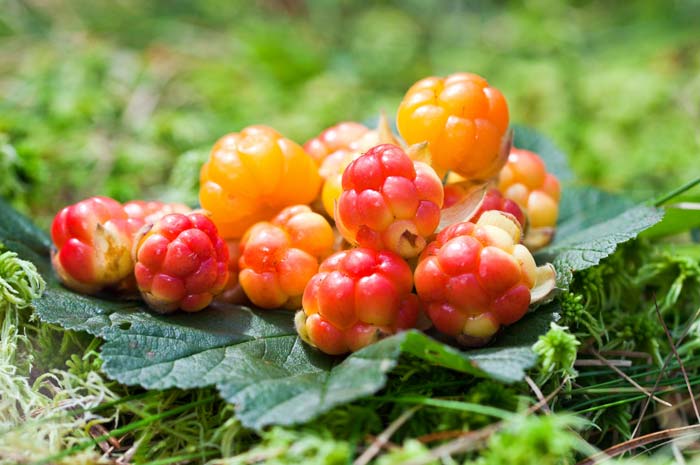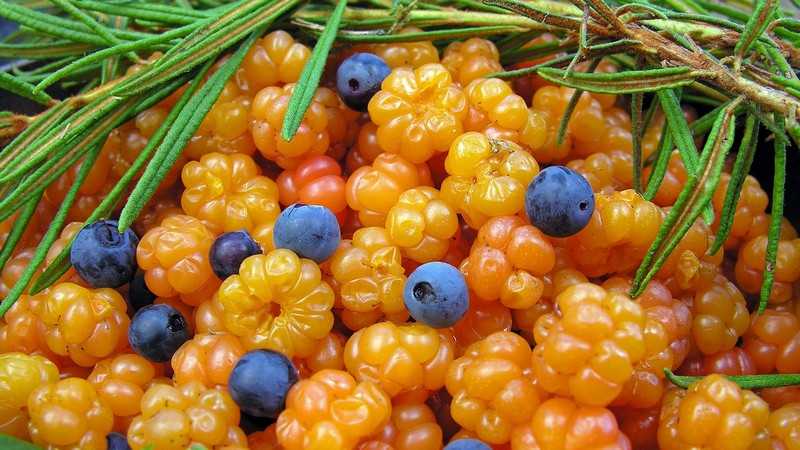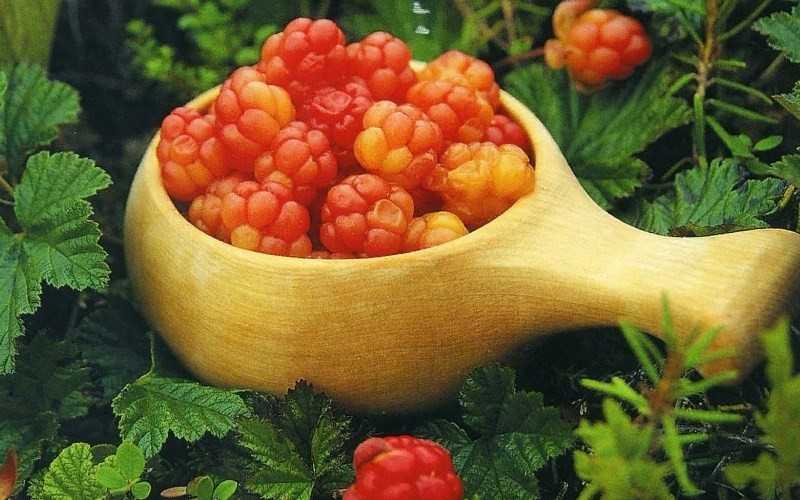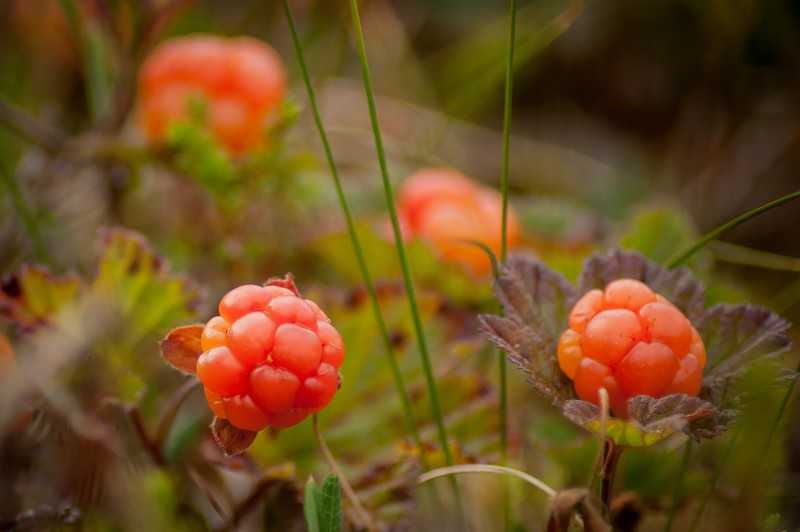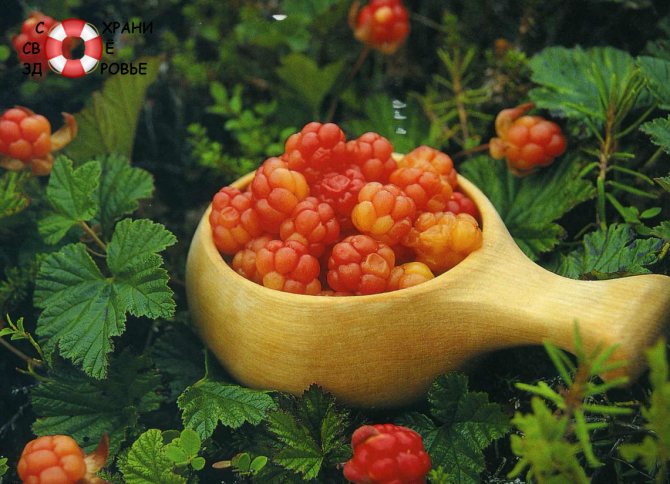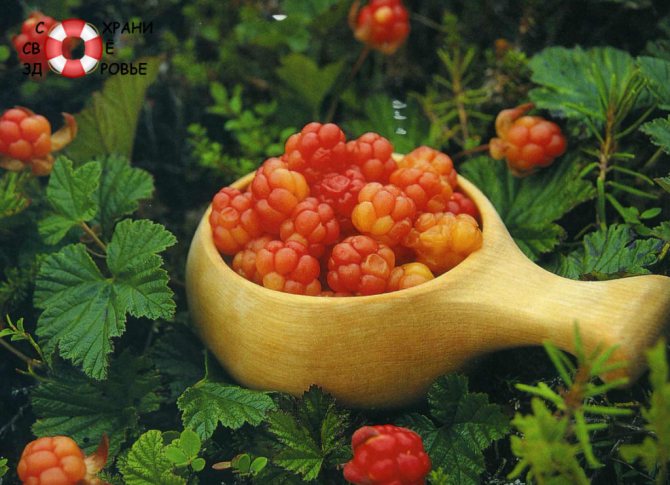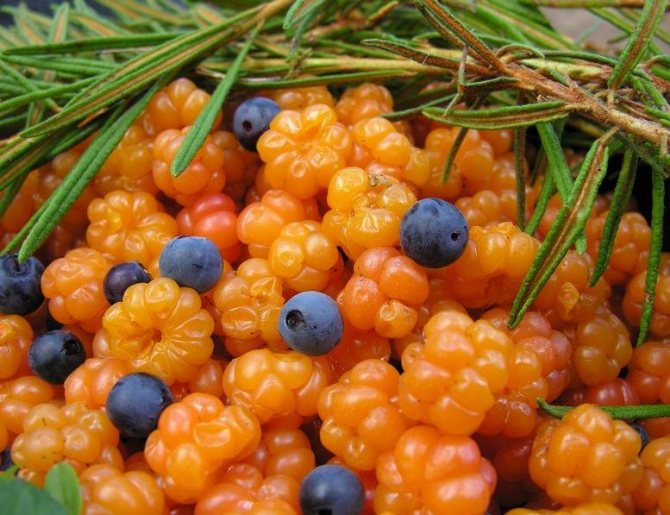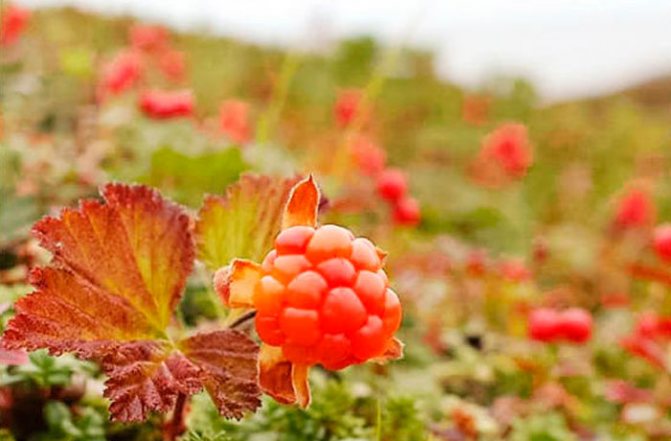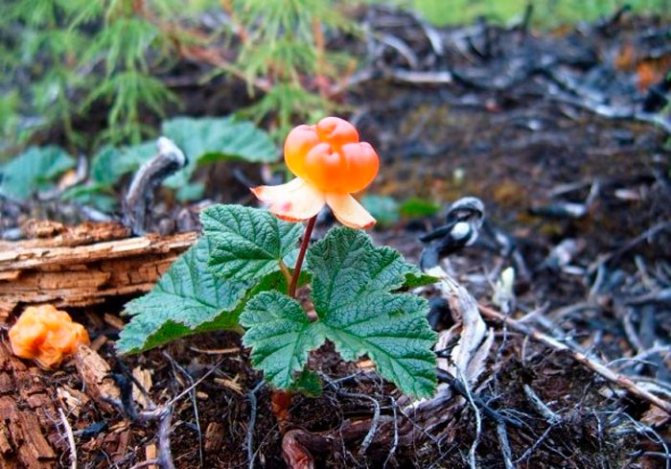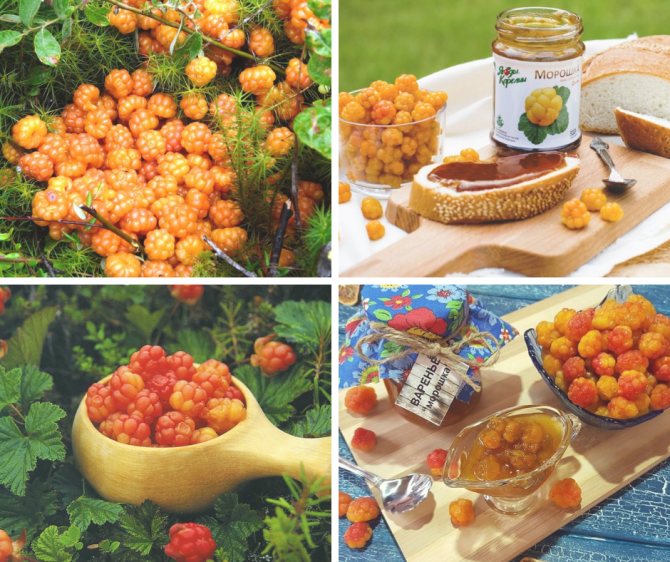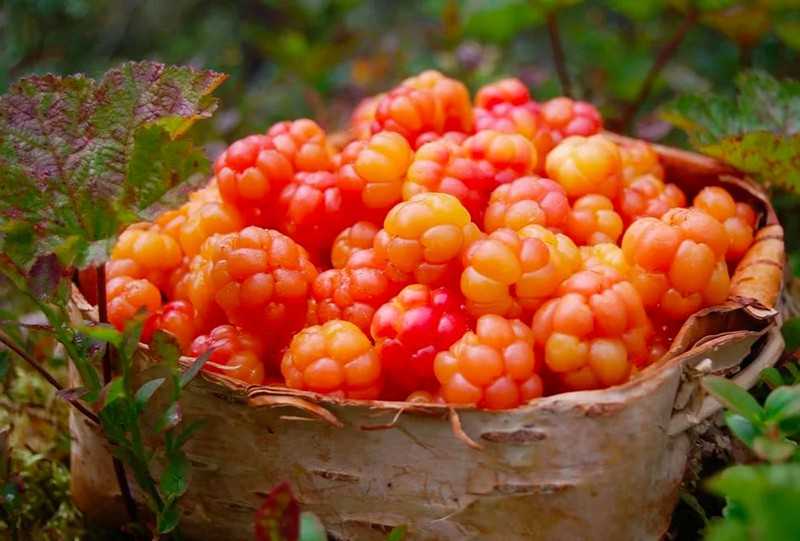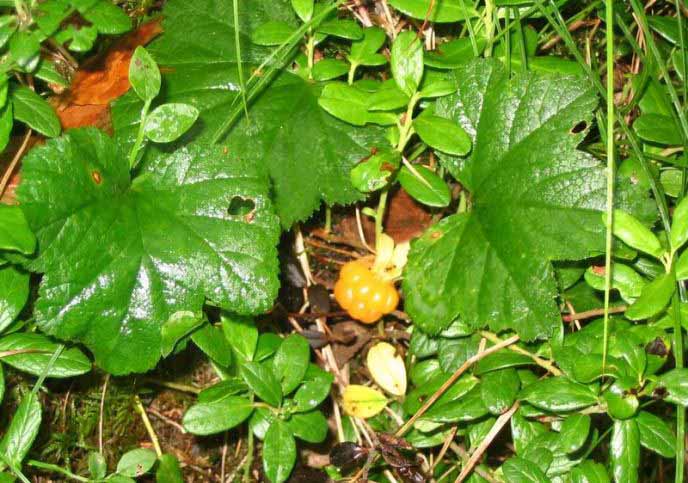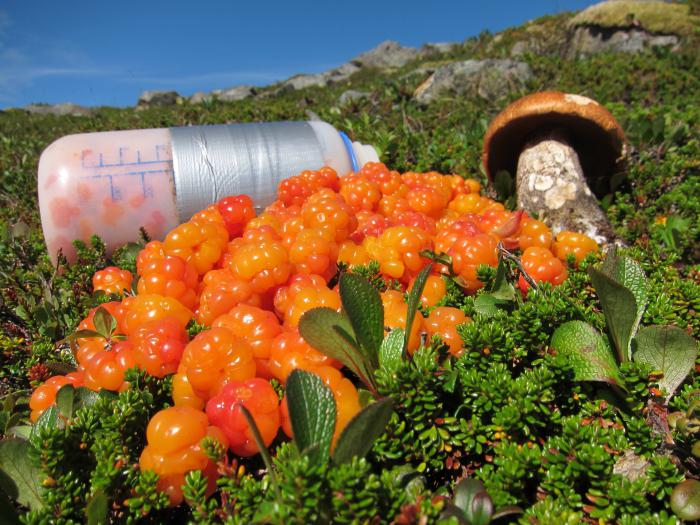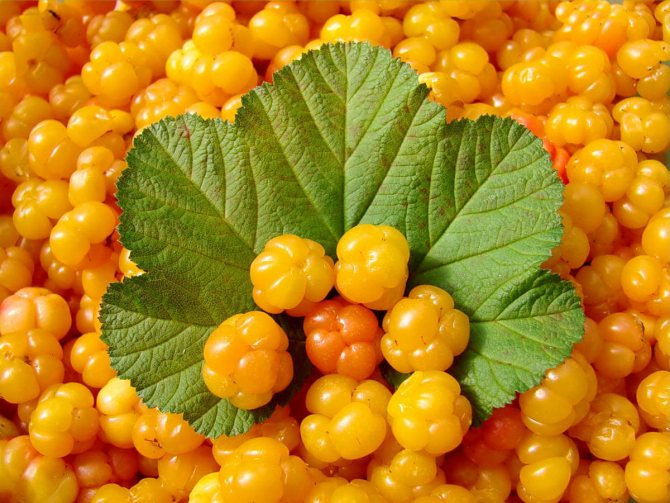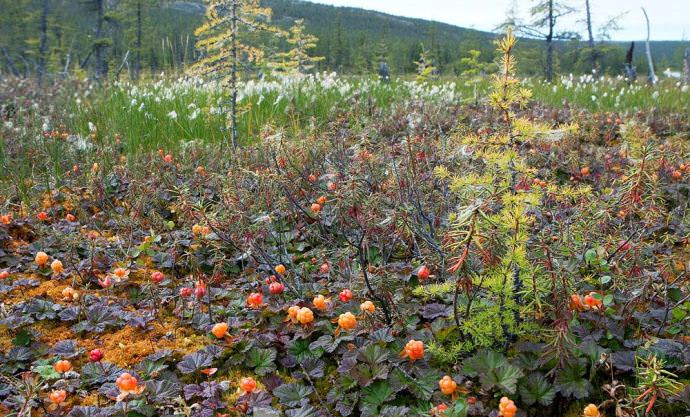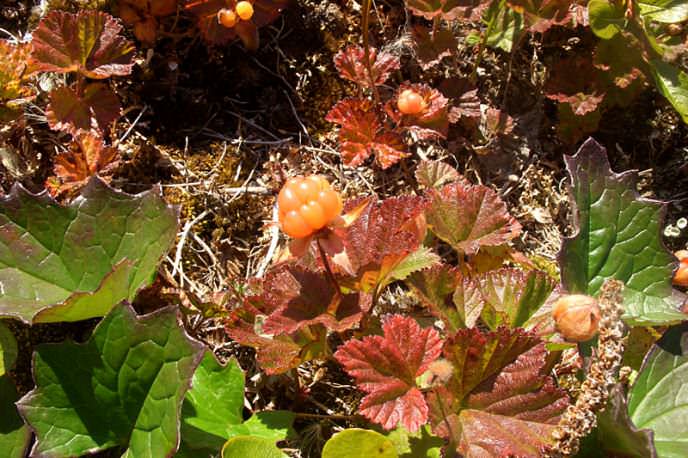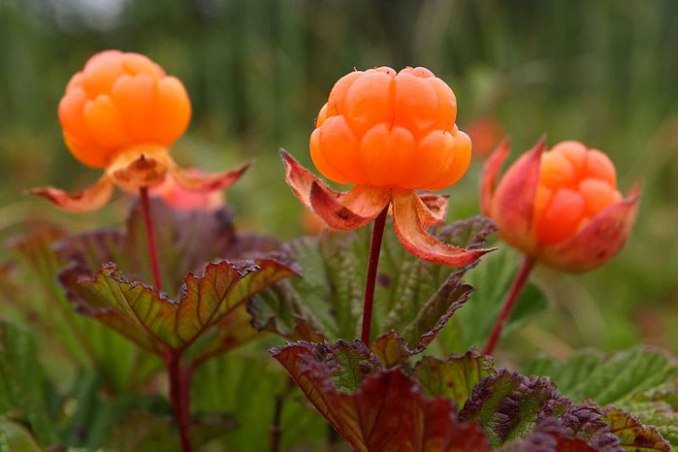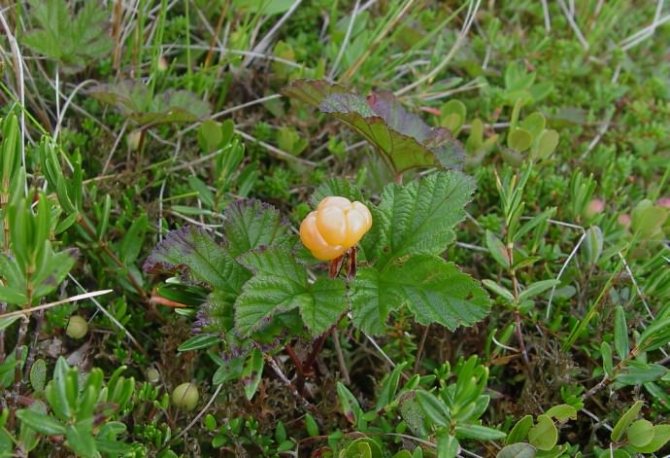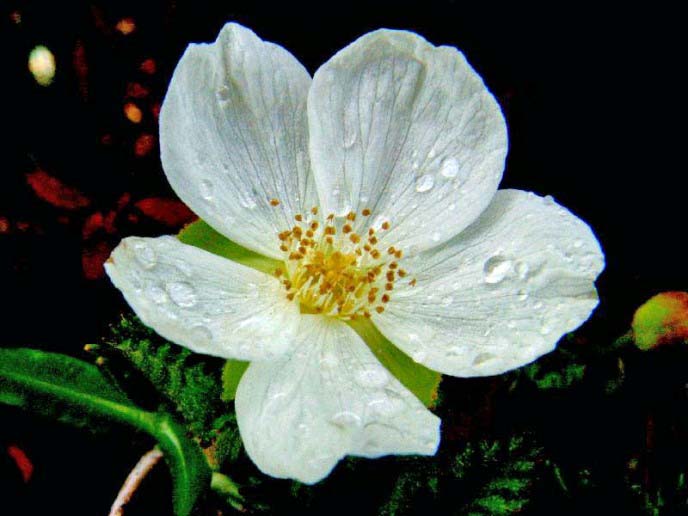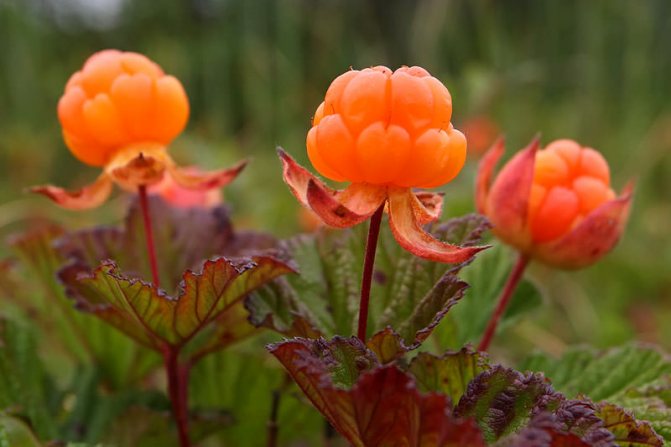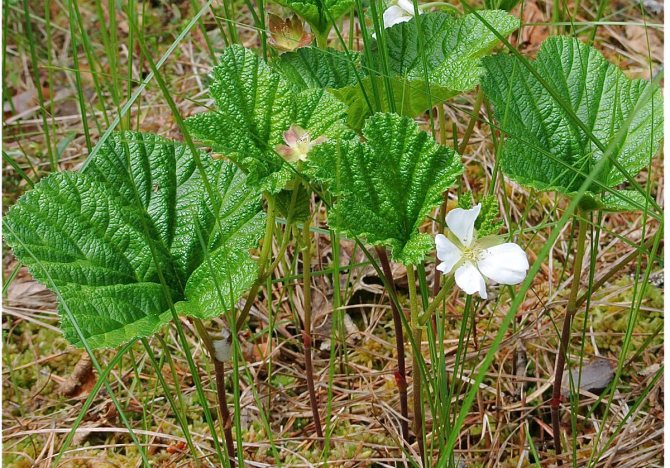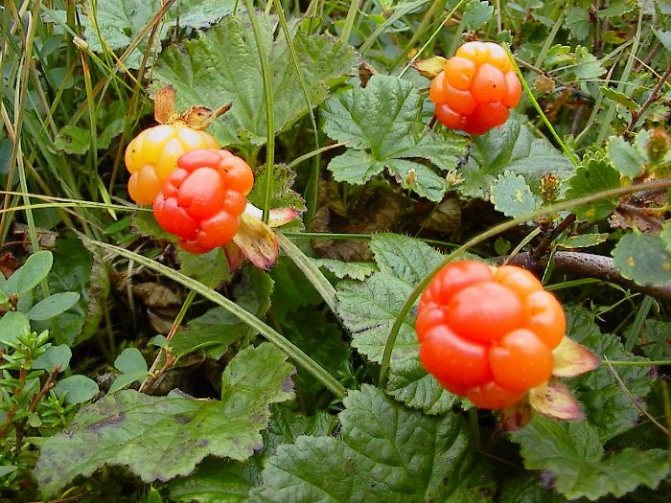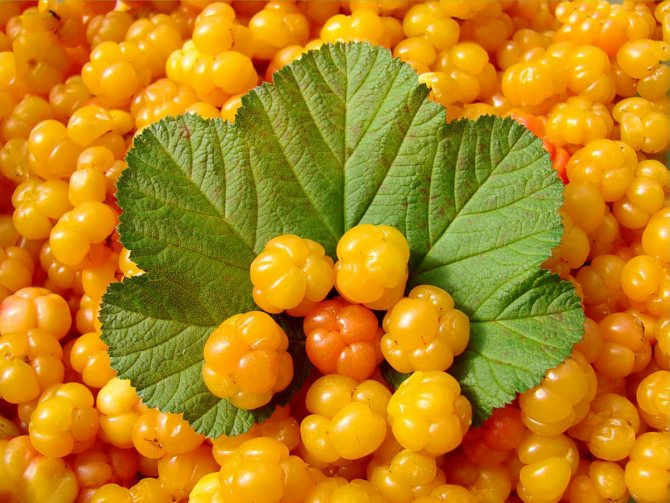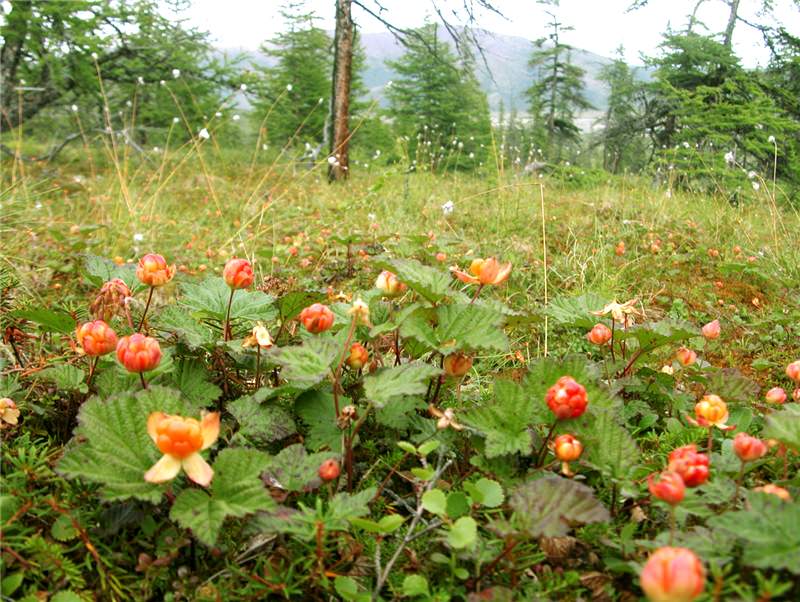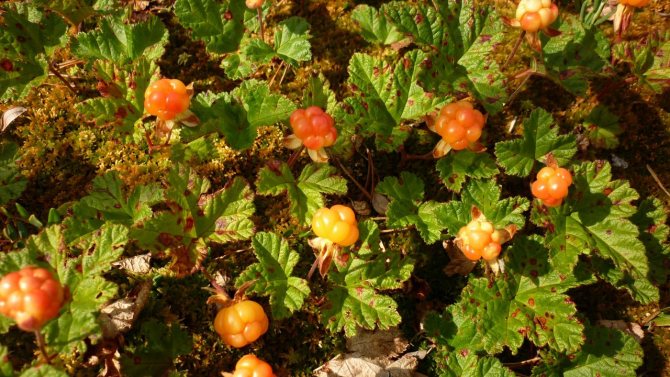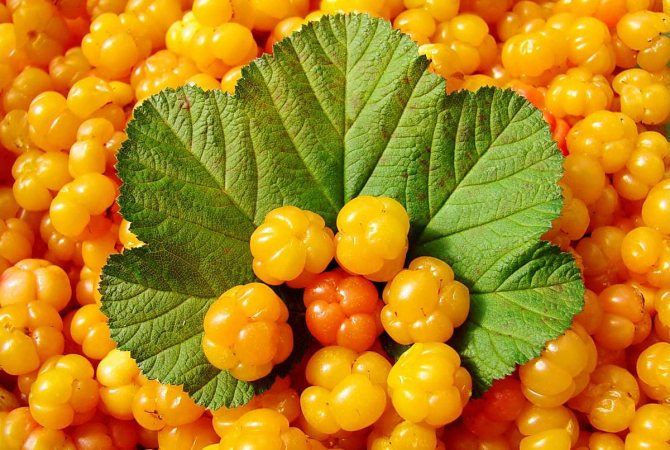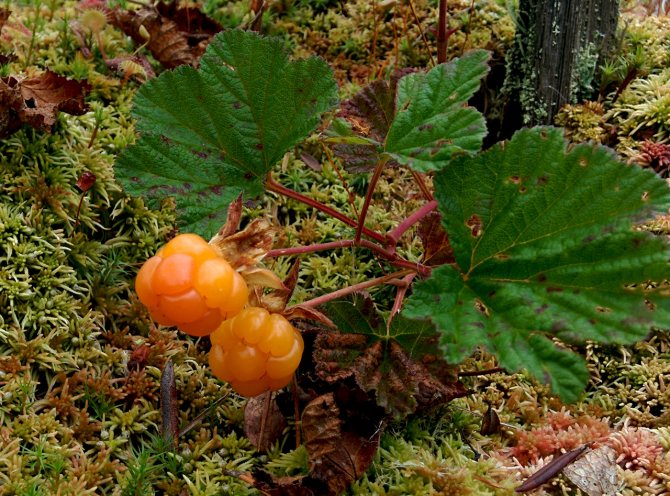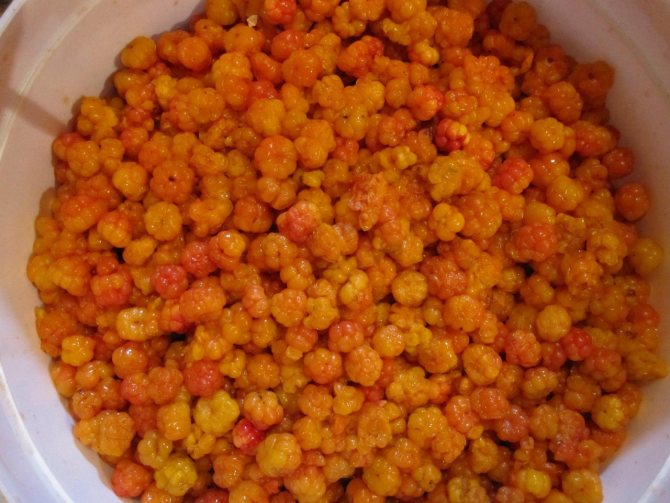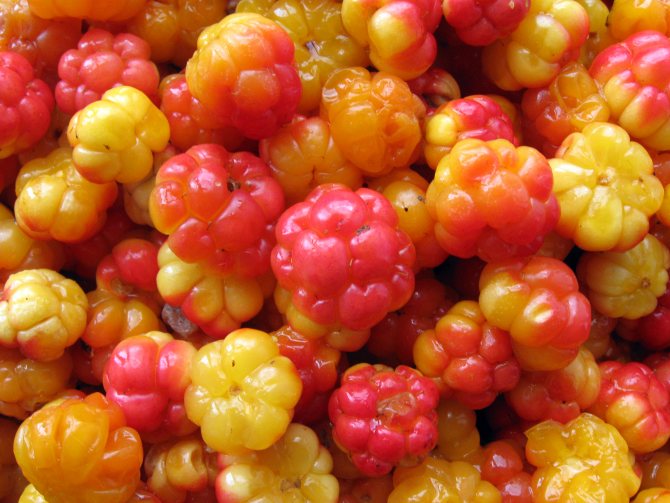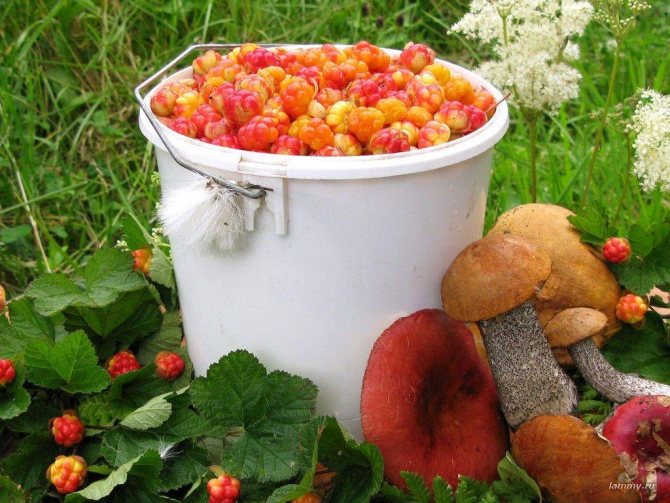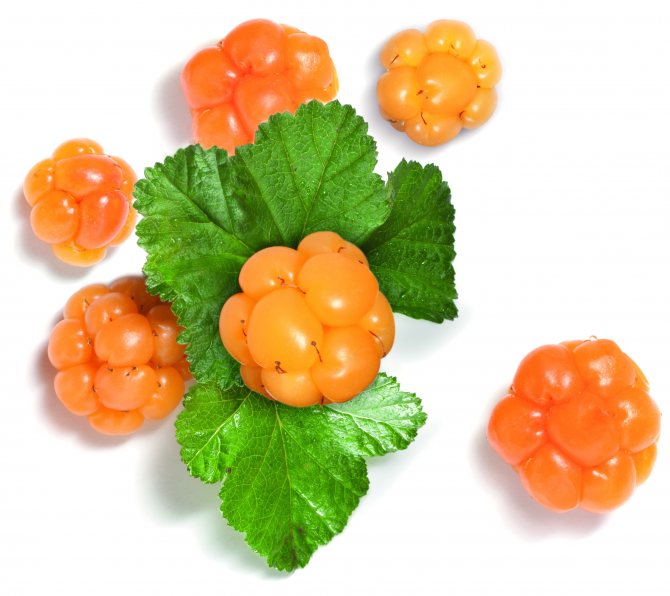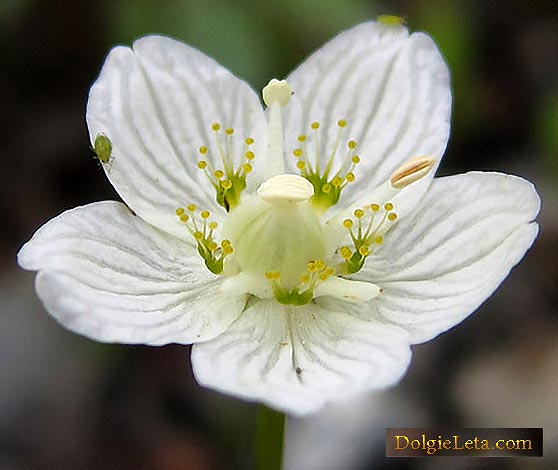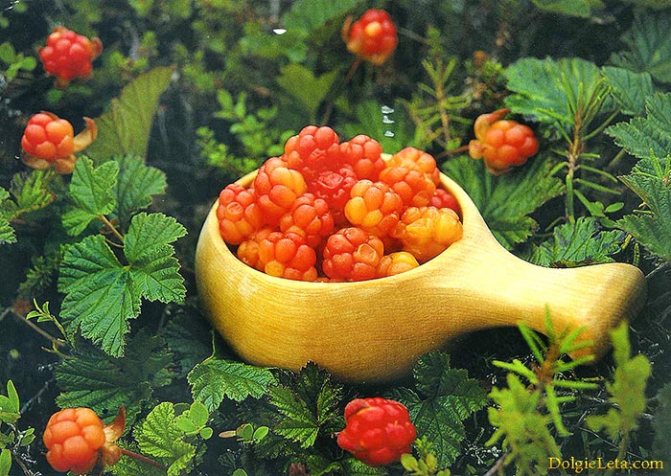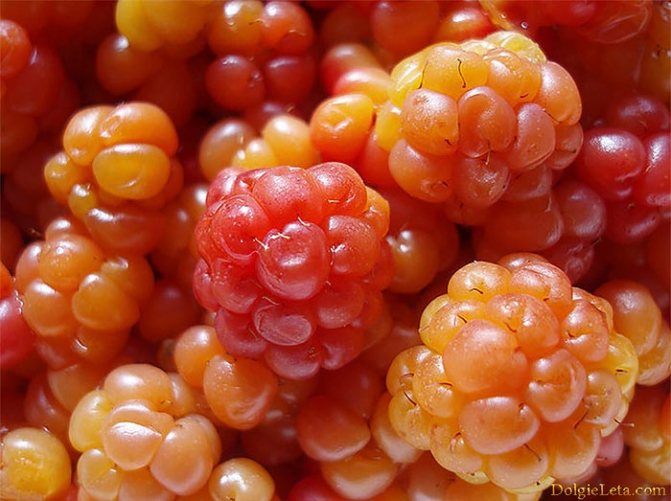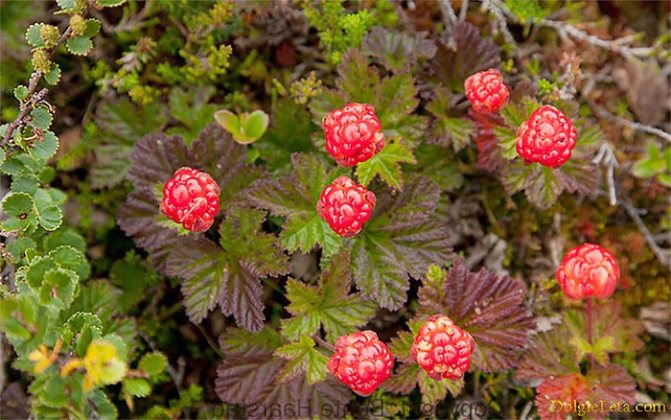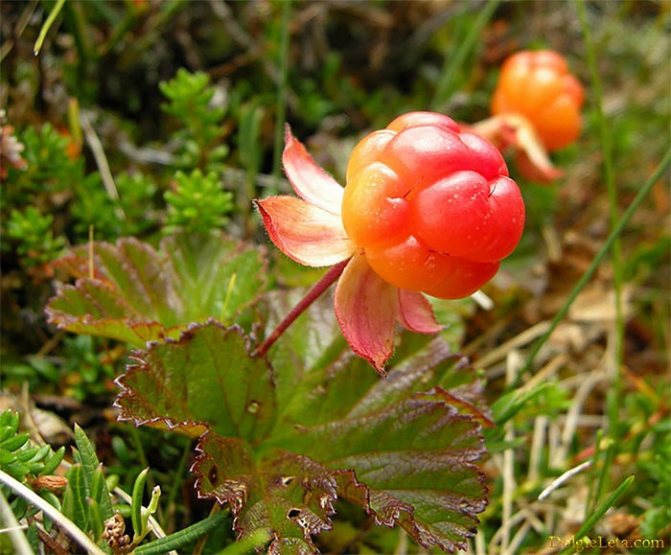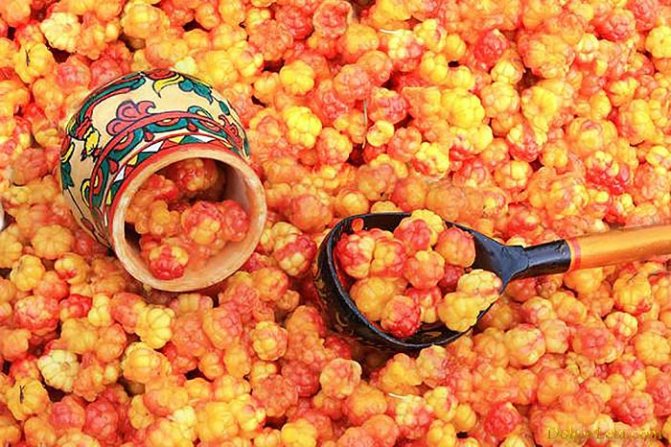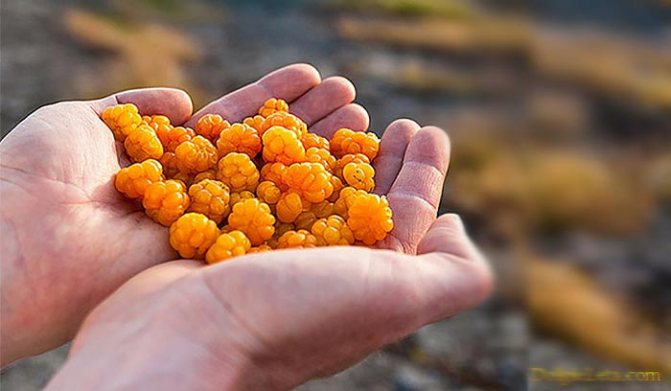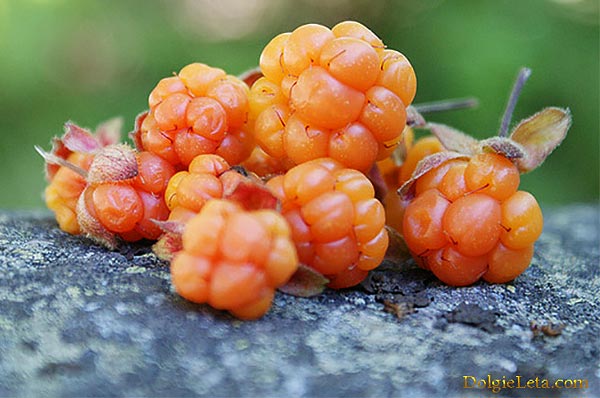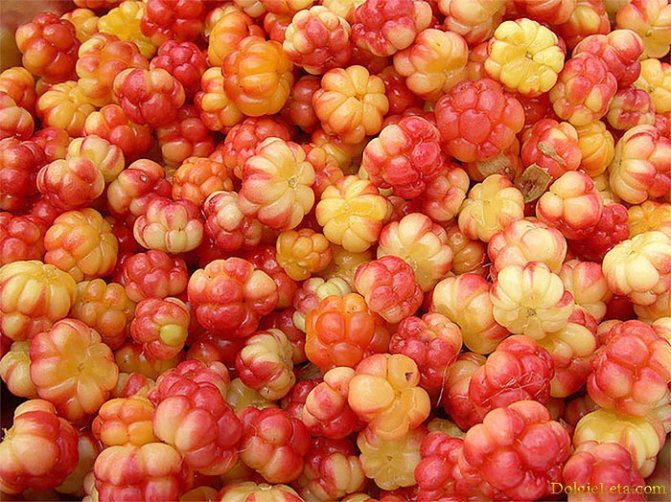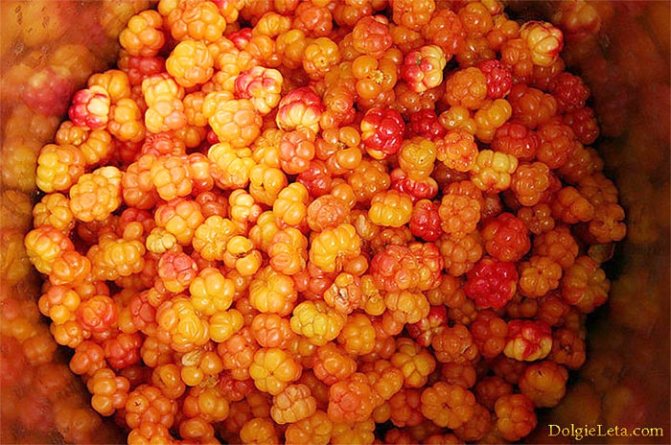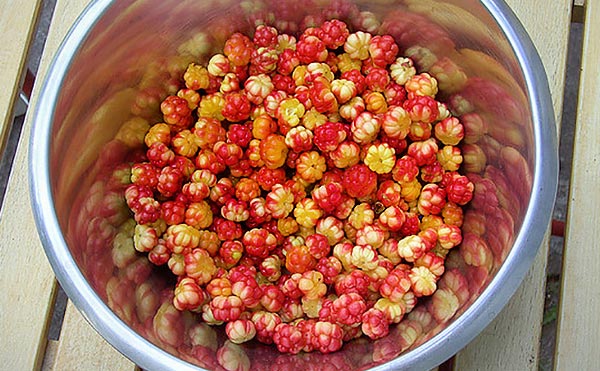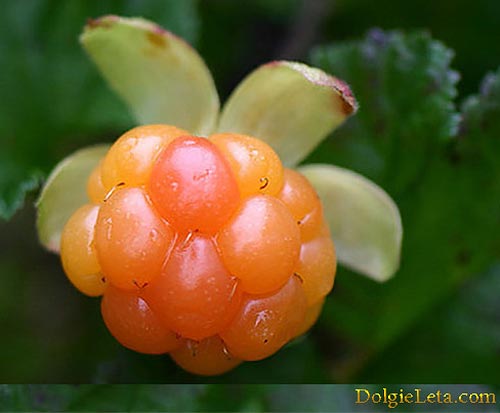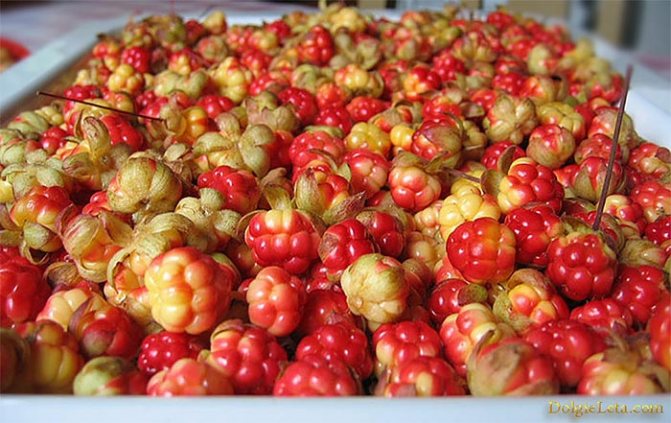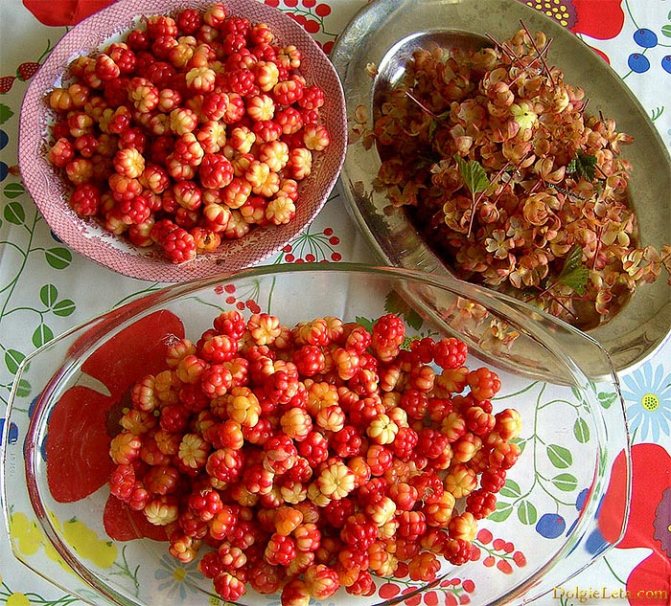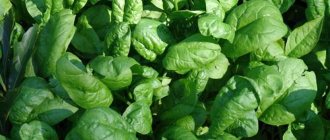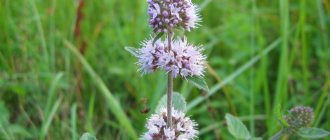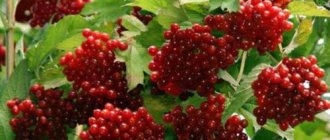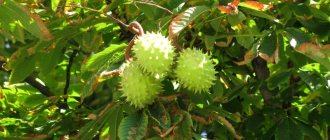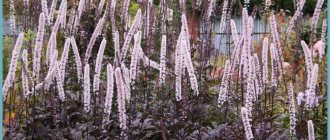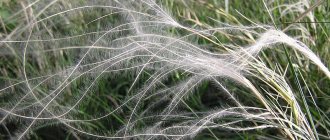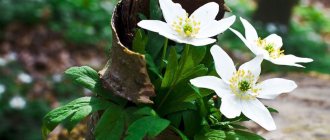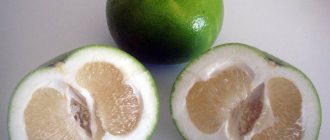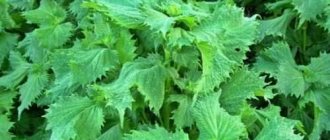Cloudberry (Rubus chamaemorus), the word rubus (from Lat.) - "red, blackberry", and chamaemorus - "silk fruit that lies on the ground." Indeed, when ripe, cloudberries look like a red silk blanket. The familiar name of the cloudberry berry has several variants of origin: one of the most common, this is the origin of the word "frost" - in the spring frost this berry ripens the very first! Due to the fact that the berry grows in the swamps, the second, but no less popular option is "frost" (from Ukrainian), which in translation sounds like "swamp".
Cloudberry is an unusual and truly amazing berry. Among the peoples of the north, there is a legend that tells of a dawn girl who skillfully embroidered a pattern with beads on girls' pimas. Suddenly a strong wind blew and scattered these beads all over the earth, and since then the dawn girl has been walking across the tundra and gathers her beads on bog bumps on the bead. Therefore, the northern peoples call cloudberries "Swamp Amber".
Photo: how Cloudberry grows
Cloudberry: general description
Cloudberry is a semi-shrub or herbaceous plant from the Rose family.The closest botanical relatives of cloudberries are blackberries and raspberries. The scientific name of the cloudberry chamaemorus literally translates as "earthen mulberry", and indeed in its shape these northern berries vaguely resemble mulberry fruits. However, unlike the mulberry, which densely clings to the branches of a tree, only one berry can grow on each stem of a cloudberry.
Cloudberry blooms, as a rule, in the second decade of June, and the berries ripen on it by the beginning of August. Cloudberry flowers are very similar to forest strawberry flowers, but the berries themselves are small, round (no more than 1.5 cm in diameter), resembling blackberries in structure. Barely set fruits are green, as they ripen, they gain color and become yellow-red and, as it were, "plastic" in appearance. Fully ripe berries acquire a pure honey-amber color and become incredibly fragrant and translucent in the light.
Attention! The cloudberry harvesting season is short. Due to the fact that the berries very quickly overripe, soften and become not transportable, it lasts no more than 9-13 days. For this reason, they try to pick off cloudberries slightly unripe, and then store them indoors.
Since the sepals of cloudberries are a valuable medicinal raw material used to treat persistent coughs, the berries are harvested along with the green leaves surrounding their stalks.
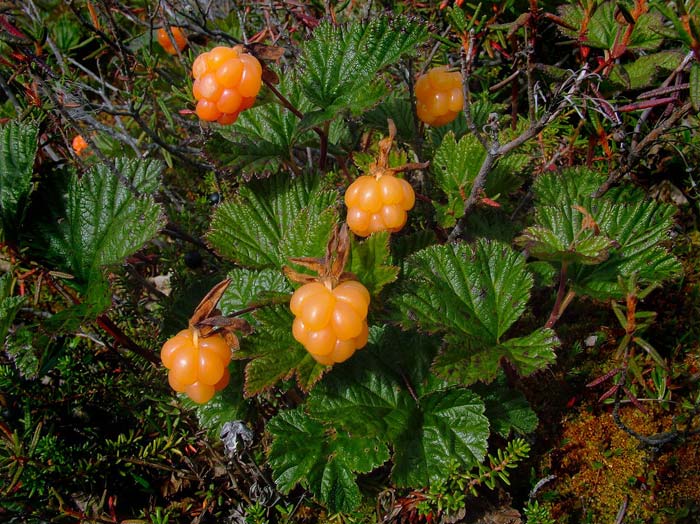
Cloudberry bush
Care features
Successful cultivation is primarily based on proper watering. In tap or well water, you need to periodically add a little citric acid at the rate of 2-3 g per 8-10 liters of water.
In order to avoid chlorosis, it is necessary to add to the soil in the spring for every square meter. m 30 g of sulfur powder. The soil where cloudberries grow should always be slightly moist, so regular watering is needed. Dry weather, summer heat, summer requires you to do it every day.
Recommendation: to improve metabolic processes, it is advisable to use special mycorrhizal granules.
Currently, the manufacturer offers various preparations enriched with mycorrhiza of fungi from the Glomus family, such as "Mikor plus." The introduction of mycorrhiza into the soil not only enriches it with useful elements, but also protects against pathogenic microorganisms, maintains acidity at the required level, and saves water for irrigation.
It is possible to introduce granules at any stage of growth, it is enough to distribute the granules by hand near the plant and slightly loosen the soil to a depth of 10 cm.In spring, the plant can be fertilized with organic and mineral fertilizers, the space between the bushes is sometimes filled with pieces of forest moss.
Growing area
Cloudberry is an inhabitant of the high latitudes of the northern hemisphere. This shy forest prefers to settle in swampy clearings, old peat bogs and moss-covered raised bogs.
In Russia, cloudberry mainly grows in Karelia, Murmansk, Arkhangelsk, Pskov and Novgorod regions, the Komi Republic and the Yamalo-Nenets Autonomous Okrug, although individual islands of this northern beauty are found in more southern regions, for example, in the vicinity of Bryansk and Smolensk. Cloudberry also grows in Belarus, but there is so little of it that it is listed in the republican Red Book, but in the countries of Northern Europe, where cloudberry grows in large quantities, it is not only harvested in the wild, but also cultivated on special berry plantations.
In which natural area does cloudberry grow
The natural habitat of cloudberries is the tundra. It is a cold-loving plant that is comfortable to grow in regions with long winters and very short summers. Feels great in the northern regions of the forest-tundra. Does not tolerate strong winds and torrential rains. And also the temperature difference is destructive for her. The crop tolerates frost better than sudden temperature fluctuations.
The plant prefers soils with high humidity, waterlogged. And this beauty also grows in mountainous areas, on plains and mounds.
Content of nutrients
The golden marsh berry, which was so highly valued by our ancestors, is a real storehouse of valuable microelements, biologically active substances and vitamins.
Wanting to praise cloudberries for their high vitamin C content, they are often called "northern orange", but this comparison is incorrect, because in fact, the quantitative content of ascorbic acid in this modest forest beauty is several times higher than in any citrus.
However, cloudberries are not only rich in vitamin C - they contain more valuable beta-carotene than in apricots and carrots, and more tocopherol than in spinach. In addition to the record amount of provitamin A, ascorbic acid and vitamin E, cloudberries contain significant amounts of niacin, riboflavin, thiamine, as well as magnesium, cobalt, silicon, iron and organic acids.
Advice. When frozen, cloudberries do not lose their beneficial properties and, which is especially important, in the fruits thawed after storage in ice, vitamin C is fully preserved.Therefore, surplus fresh cloudberries in summer can be loaded into a low-temperature freezer, and in winter they can be used as needed.
How to use it correctly?
Fresh cloudberries are consumed daily as an independent dish during the ripening season.
It is very useful to eat soaked cloudberries, due to the activity of bacteria, its beneficial properties increase slightly. In addition, properly cooked soaked cloudberries can be stored without deterioration for about two years.
You can wet cloudberries with or without sugar. First, the berry is sorted out, washed and allowed to drain off excess water. Large jars are filled up to the shoulders and poured with cooled boiling water. Tied with gauze, folded in several layers, and put for 2-3 months in a cool place, where the temperature is not higher than 2-5 degrees Celsius.
You can add a glass of sugar for each liter of boiling water, boil for 10 minutes, strain, cool and pour the berries. If a lot of berries are harvested, then you can soak cloudberries in small wooden barrels, in addition to sugar, you can add cloves and other spices to the marinade.
Advice: despite the pleasant taste, you need to observe the measure and not overeat, it is enough to eat 200 g of fresh berries at a time.
Compotes, preserves, cloudberry jams are prepared in the same way as from raspberries or blackberries. At present, due to the reduction of natural plantations of this crop in many regions, it has been assigned a protected status. Therefore, amateurs can grow cloudberries on their own.
Useful properties of cloudberries
Due to the high content of trace elements, biologically active substances and vitamins, cloudberries:
- normalizes the action of the digestive system and suppresses the growth of pathogenic intestinal microflora;
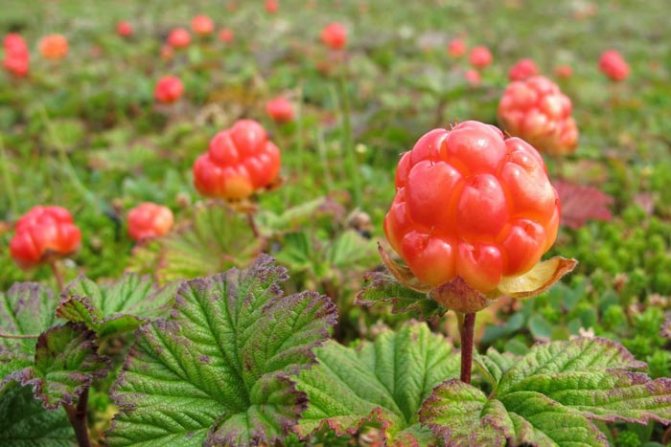

Cloudberry is useful for strengthening the immune system
- has a bacteriostatic effect, stimulates tissue regeneration and thereby promotes healing and cleansing of festering wounds and burns;
- produces a mild diuretic effect, which helps to eliminate edema of the lower extremities;
- accelerates metabolism, which, coupled with a diuretic effect, contributes to weight loss in obese patients;
- improves the condition of the skin, mucous membranes and horny formations (nails and hair);
- effectively lowers blood pressure;
- stimulates the immune system, thereby increasing the body's resistance to the effects of adverse factors of various etiologies;
- increases the general tone of the body, and thereby shortens the rehabilitation period after a long illness;
- is an excellent antiscorbutic agent, and also prevents the development of winter-spring beriberi;
- suppresses the production of free radicals and thereby slows down the aging process of cells;
- helps to reduce the level of "bad" cholesterol, increases elasticity and reduces the permeability of the walls of blood vessels.
Reproduction
You can propagate plants:
- seeds;
- cuttings.
For propagation by seeds, you can prepare them yourself from fresh fruits or buy them. If the seeds are obtained from harvested berries, then they are sown immediately in open ground in the fall.
If the seeds are purchased and their quantity is limited, then they must be sown in boxes filled with wet peat or its mixture with sand (4 to 1). This should be done immediately after purchasing the seeds. If you keep them until spring, then most likely they will not germinate.
After that, put the box for 30 - 40 days where it is not warmer than + 3 + 5 degrees. After that, they are moved to a warm room, kept at a temperature of + 20 + 25 degrees.
Keep in mind: the first garden varieties have now appeared, mainly of Finnish or Norwegian selection.
In the spring, seedlings are planted in a prepared place. If there are already adult bushes, then you can cut the cuttings, try to root them using small greenhouses. If rooting is successful, then in the summer or next spring, the bushes are planted in a permanent place. For successful pollination, you need to have many plants so that male and female plants fall among the bushes. As a rule, male plants are much larger than female ones.
Medicinal use
In folk medicine, not only berries have found application, but also leaves, roots, and also sepals of cloudberries.
Fresh cloudberry juice is used to lubricate burns and poorly healing wounds, and its berries are used to strengthen the intestines in case of non-infectious diarrhea. Sepals are brewed and given tea to patients suffering from severe bronchial cough.
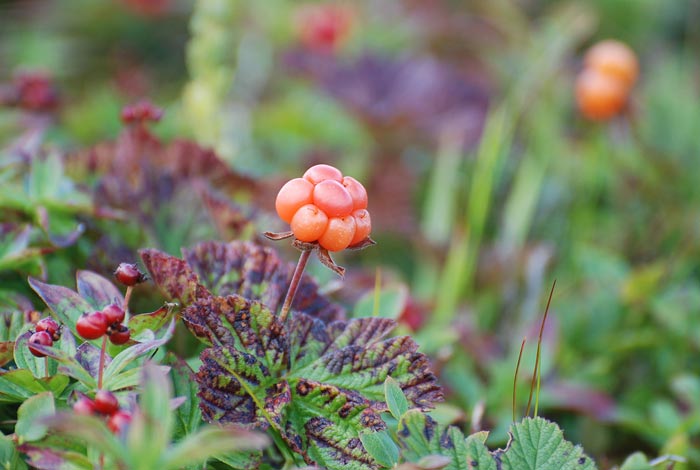

For medicinal purposes, both berries and cloudberry leaves are used.
In addition to such a healing tea for the treatment of whooping cough and bronchitis, I also use cloudberry foliage infusion, and a decoction from its roots is given to patients suffering from cystitis or edema caused by renal failure.
Preparation
Not only jam and jelly are prepared from it, it is also pickled and dried, liqueurs, compotes and marshmallows are made.
Fresh berries are poorly stored and after three days the fermentation process begins. Therefore, it is recommended to do some seaming, keeping it for a long time.
Soaked cloudberry
To prepare it, you will need not quite ripe berries and a tub in which the berries will be soaked. A syrup is prepared from one glass of sugar and a liter of water. Berries are poured into a tub, and syrup is poured on top, the water with sugar should be on the same level with the berries. The tub is closed with a lid and left for four months. Soaked cloudberries are used as a filling for closed pies, and also added to compotes and jelly.
Jelly
You will need one kilogram of sugar, the same amount of berries and thirty grams of gelatin. Pour sugar over the berries and simmer. Gelatin is diluted in water and after a while is added to the jam, boiled for another 15 minutes and poured into jars.
Contraindications
Due to the high content of organic acids, cloudberries should be used with caution by ulcers, as well as people suffering from gastritis and enterocolitis. In case of exacerbation of the above diseases, fresh cloudberries must be completely excluded from their diet.
Attention! Since cloudberry has the ability to lower blood pressure, it should not be used for hypotensive patients, as well as for patients undergoing treatment with antihypertensive drugs.
In addition, eating large amounts of cloudberries can cause hives or diathesis in allergy-prone people.
To maximize the benefits of cloudberries, you need to eat them fresh, however, even dried or frozen berries will bring tangible benefits to the body and at the same time diversify the not-so-extensive winter diet.
Landing rules on the site
Cultivation on an industrial scale began in the 60s of the last century in Norway and Finland. Domestic gardeners are just mastering this culture.
Before planting, the following activities are carried out, as a result of which the planting site looks like a layered "cake" made of polyethylene and soil:
- choose an illuminated area;
- dig a trench, about 0.5 meters deep and about the same width;
- take dense polyethylene, make small holes over the entire area;
- lay it at the bottom of the trench;
- fall asleep with a layer of soil;
- another layer of polyethylene is laid;
- cover it with a layer of soil;
- the upper, fertile part of the soil is mixed with peat in a ratio of 2 to 1;
- with the resulting mixture, fill the trench to the top and spill it well with water.
Take note: for successful cultivation, you need to create conditions on the site that are as similar as possible to natural ones. If possible, then part of the soil must be brought from the place where this berry grows.
After that, you can sow seeds in the prepared areas in the fall, or plant seedlings of this culture in the spring. For a more successful development of plantings, you can place nearby bushes of marsh wild rosemary, blueberries or lingonberries.
What to cook from cloudberries
It is clear that raw berries are the healthiest and contain the maximum amount of medicinal components. But the season for fresh cloudberries is very short, and you want to enjoy the healthy berries as long as possible. In the northern regions, it is customary to harvest cloudberries in the form of jam, juices, compotes are prepared from it, added to desserts, whole berries are frozen or puree from them. In Finland, a liqueur is made from cloudberries, which got its own name - lakka, and is famous for its beneficial properties. The Swedes add berries to mushroom dishes and cheese, while the British use cloudberries in desserts.
Collection, drying and storage of raw materials
Cloudberries are harvested at different times, depending on which part of the plant is needed for collection:
- the fruits are harvested in the middle of summer, after the berries turn yellow-orange, the sepals are also plucked with them;
- leaves are plucked from the plant in late May or early June, after the formation of buds;
- flowers are also harvested in early summer during the appropriate flowering period;
- cloudberry roots are dug up in autumn to mid-October.
Cloudberry fruits are not only eaten immediately or frozen.They can also be dried along with the roots and green parts of the plant. To do this, the leaves, fruits, sepals and roots are washed and laid out in a warm, dry place away from sunlight. When the raw material is completely dry and begins to crumble in the fingers, it is laid out in glass jars and stored in a dark and dry place.
Fresh berries are stored in the refrigerator for no longer than 5 days, dried ones - up to 2 years. After drying, the leaves and sepals also retain their beneficial properties for 2 years, and the roots can be stored for up to 3 years.
Interesting Facts:
- It is known that Alexander Pushkin was very fond of cloudberries. Before his death, the poet asked to give him pickled berries.
- The peoples of the North have never known what scurvy is. They first heard about this disease from the Russians. This is because cloudberries have never disappeared from the daily diet of these peoples.
- This berry is one of the symbols of Finland, the image of a cloudberry is on the 2 euro coin. But the real leader in the collection and processing of cloudberries is Canada.
Cloudberries can be found not only in the wild, often this plant grown in dachas and household plots. And they do absolutely right: it is unpretentious, frost-resistant, and also incredibly tasty and unusually healthy.
Tver region
Of course, many are interested in the question of whether cloudberries are found in Moscow? No, the berry does not grow in the Russian capital. But Muscovites, if they wish, can go to a neighboring region, namely to the Tver region and pick up "moss currants" in a swampy area, not far from the town of Vyshny Volochek.


This is another iconic place where cloudberries grow. Sixteen kilometers from Vyshny Volochok is Lake Metz, in the marshy surroundings of which you can also pick delicious berries.
Photo gallery
Harvest
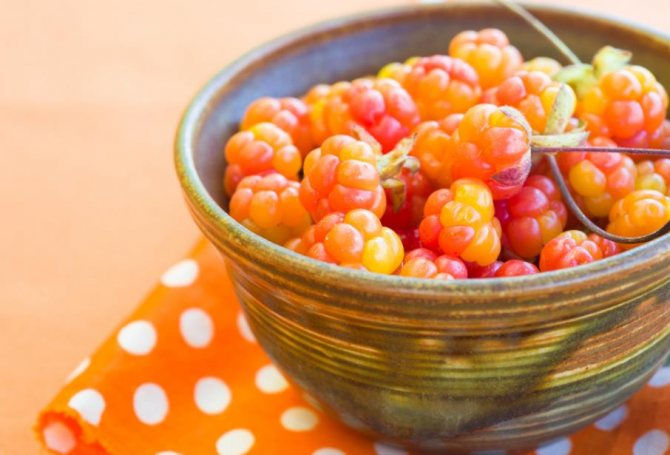

You shouldn't delay harvesting cloudberries - this berry will ripen quickly. They are cut off from the bush together with sepals, which are then dried and used for brewing in tea. The berries are usually harvested in July, when they are orange-red and slightly unripe. Fully ripe berries instantly turn into gruel. After the cloudberries have been harvested, you should immediately start processing them. If you plan to freeze the berries, make jam out of them - they do this on the same day. Otherwise, they will acidify and become unusable for further use. It is worth paying attention to the fact that cloudberry shoots are annual. Those that bear fruit this year will die off, and new ones will appear in the spring. Therefore, after the harvest is complete, you need to clean up the plantation - using garden shears or pruning shears, cut off old shoots. If this is not done, the next year there may be difficulties with the germination of young shoots, therefore, loss of yield.
Login to the site
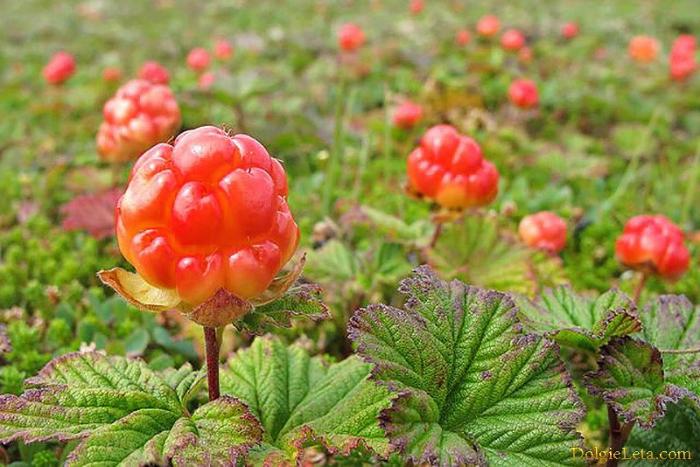

Beautiful, healthy and tasty, cloudberries have been a favorite dish of the Russian tsars since ancient times, and not in vain! Regular consumption of fresh cloudberries, soaked or mashed with honey, will give health, longevity and good mood Cloudberry is a natural jewel of the Russian North
|
|
Extraordinary healthy northern cloudberry belongs to the family Rosaceae and is related to raspberries and blackberries. The barely set cloudberry berries are first green, then turn red, and, when ripening, acquire a beautiful orange-yellow, clear and transparent amber hue. They taste sweet and sour with a strong pleasant aroma.
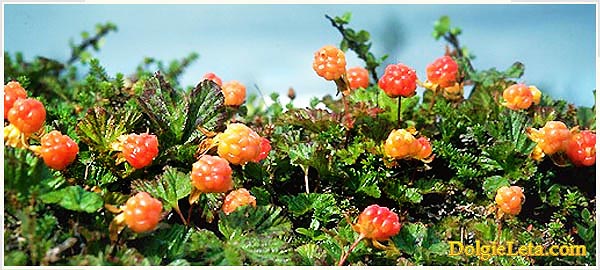

Since fresh and soaked cloudberries have been a favorite delicacy of Russian tsars since ancient times, they have earned the right to bear the proud title. "Royal berries".
|
|
Where does cloudberry grow and where is it harvested
In Russia, it is common in the Bryansk, Smolensk, Kaluga, Pskov, Murmansk, Norilsk regions, in Karelia, the Komi Republic, Arkhangelsk, in the Far East.In Belarus (Republic of Belarus), although cloudberries are found, they are so rare that they are listed in the Red Book. Cloudberry is widespread in Northern Europe - Sweden, Denmark, Finland, where it is not only a commercial berry, but also cultivated.
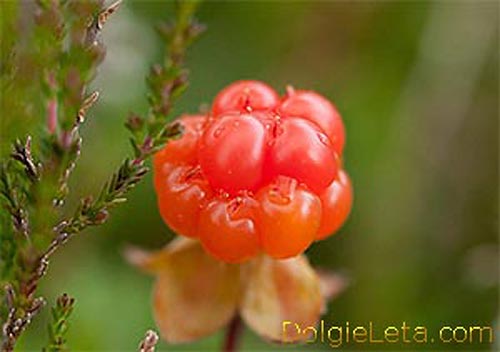

Despite the love for the northern latitudes, the cloudberry is paradoxically very capricious, fearing severe frosts, winds and rains. In other years, unfavorable weather conditions lead to a strong drop in its yield. Poor ecology and hunting for wood grouses (who eat cloudberries and thereby contribute to their reproduction through undigested seeds) also negatively affect the yield of this berry.
|
|
Collecting cloudberries is a rather laborious undertaking, as they "prefers" to settle in secluded forest bogs and peat bogs, often adjacent to sphagnum mosses, lingonberries, blueberries and wild rosemary. Cloudberry berries grow on a stem one by one, so collecting a whole handful at once will not be possible.
When ripe and when cloudberries are harvested
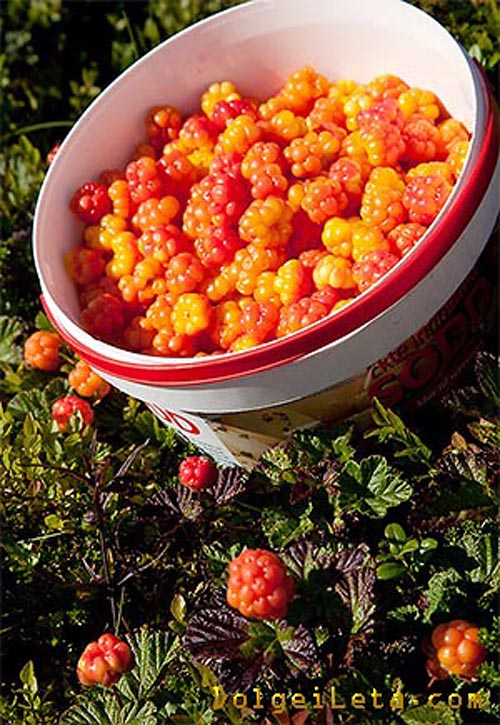

It blooms in May-June and ripens by early or mid-July... It can be harvested for only 10-14 days, since the berries overripe very quickly, begin to flow and become non-transportable. That is why cloudberries it is recommended to harvest a little unripewhen the berries are still red. At home, they will ripen in 2-4 days. Be sure to pick cloudberries together with sepals (green leaves around the berry itself), as they are dried and subsequently used as a medicinal expectorant.
|
|
Vitamins in cloudberries
This modest northern berry is a treasury of useful and nutritious substances, in particular, such vital vitamins as C, A, E, B1, B2, PP.
- Cloudberries contain much more vitamin C (ascorbic acid) than in citrus fruits (therefore, cloudberries are also called "northern orange"). Vitamin C strengthens the heart and blood vessels, has a positive effect on the nerves, helps to cure flu, colds, and other infections. Vitamin C promotes the removal of radionuclides and accumulated heavy metals from the body, accelerates the healing process of wounds and scars, increases overall tone, gives vigor, and increases efficiency.
- Vitamins A and E have a good effect on immunity, significantly increasing resistance to cancer and viral diseases. Vitamin A (retinol acetate) improves the functioning of the thyroid gland, slows down the aging process, rejuvenates the skin, controls the intrauterine development of the fetus, which makes it absolutely indispensable for pregnant women. Vitamin E (tocopherol) is actively involved in the synthesis of hormones, tissue regeneration, and cell renewal.
- Vitamin B1 (thiamine) - an element vital for the proper functioning of the brain and nervous system. It helps to properly concentrate on the tasks at hand, improves mental performance and memory, and stimulates muscle development during training.
- Vitamin B2 (riboflavin) has a positive effect on vision, protecting the eyes from the development of cataracts, strongly stimulates the production of antibodies, which seriously increases the body's resistance.
- Vitamin PP (nicotinic acid) is a powerful agent for the prevention of diabetes and atherosclerosis, helps to cleanse toxins.
|
|
In addition to vitamins, cloudberries are extremely rare rich in macro- and microelements: potassium, magnesium, sodium, phosphorus, iron, silicon. In terms of the content of beta-carotene, useful for immunity, it is not inferior to carrots or apricots.
Why cloudberries are useful
To heal the body, not only the berries themselves are used, but the roots, leaves and sepals. Cloudberry is very useful for stomach ailmentsbecause it reduces inflammation of the mucous membrane and has astringent properties. It stops diarrhea and prevents dehydration.
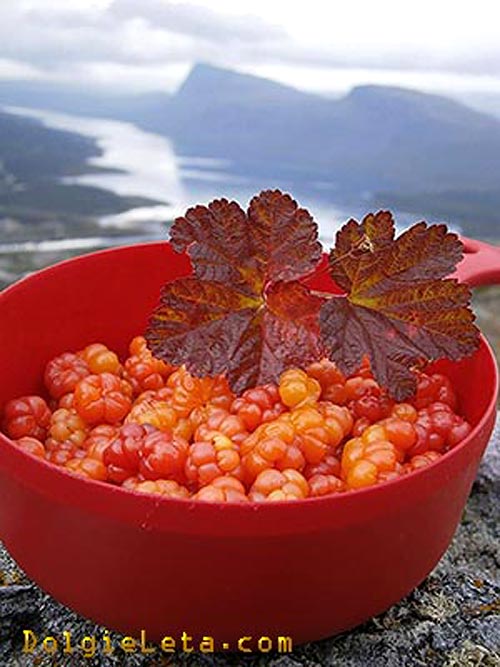

Because cloudberries are diaphoretic, they used for colds and febrile conditions. She is knocks down fever and removes harmful substances. It is used as invigorating agent with severe fatigue, stress, general weakness and anemia. It is an excellent medicine for various types of stomatitis and tonsillitis, helps with vitamin deficiency. It is good to give it to weak and rickety children. The inhabitants of the North have long used cloudberries as an affordable and effective remedy for scurvy.
|
|
Cloudberry normalizes metabolism, cleans blood vessels from "bad" cholesterol, has a highly positive effect on the kidneys and liver. She is reduces high blood pressure and therefore useful for hypertensive patients. Since it is low in calories, it is a dietary product and is great for those looking to lose weight. The presence of vitamins A and E in large amounts makes cloudberries extremely useful for expectant mothers.
Berry juice, which has bactericidal and regenerating properties, is used in the treatment of skin diseases, for healing wounds, and getting rid of acne. Cloudberry extract, rich in antioxidants, is used as a tonic and moisturizer in cosmetics. Cloudberry-based rinses and shampoos strengthen hair, restore damaged structure, add shine and refresh its natural color.
Cloudberry oil, which has a characteristic delicate berry aroma, is obtained from the seeds of the plant by the squeezing method. It moisturizes and nourishes dry skin... Healing oil will benefit not only the skin, but also the nails and hair. It is often used as a component in medicinal cosmetics, foams, gels, liquid soaps, and anti-aging creams.
Contraindications
In the case of individual intolerance, cloudberries, such as raspberries, can provoke a rather serious allergic reaction, accompanied by hives and itching. Since cloudberries contain a significant amount of organic acids, it is contraindicated for those suffering from duodenal and stomach ulcers, with enterocolitis, with exacerbations of chronic gastritis with abundant secretion of digestive juice.
Because she is lowers blood pressure, you can not take it together with drugs for hypertension. Cloudberry juice should not be used for severe kidney damage. If in doubt about the use of cloudberries, you should definitely seek professional medical advice.
Cloudberry sepals
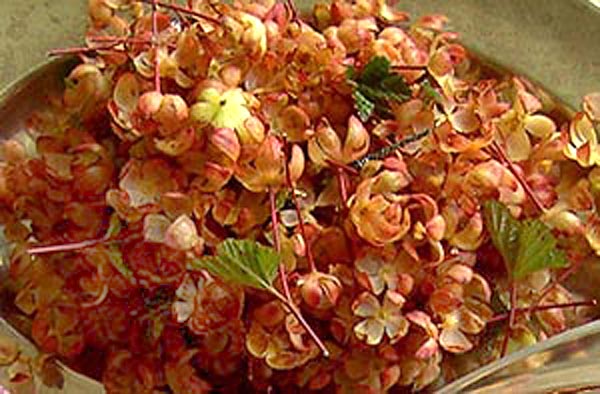

When picking berries, sepals are also collected with it. Them dried and brewed, as a remedy for general loss of strength, depression, in the absence of appetite. It is enough to add a pinch of dried sepals to regular tea for it to acquire a strong pleasant aroma and piquant fresh taste.
|
|
They are wonderful help with a strong cough, including useful for whooping cough and bronchitis. To cook a healing herbal infusion, you need to take 1 teaspoon of dried sepals, brew with a glass of boiling water, cover with a saucer and let it brew for several hours.
How to brew cloudberries
Decoction of leaves and roots prepared as follows: 1 tablespoon of a dry mixture of leaves and roots is poured with 250 g of water, boiled and left over low heat for 3-4 minutes. Cover tightly with gauze or a saucer and leave warm for 2 hours, then filter. Drink the broth 3-4 times a day before meals, a quarter of a glass as a remedy for cystitis and edema associated with impaired renal function.
Deciduous infusion for the treatment of cough, whooping cough, bronchitis and hemoptysis is prepared as follows: a tablespoon dry cloudberry leaves poured with a glass of boiling water, covered and kept in a warm dark place for 4 hours. The strained infusion is taken 4 times a day for a quarter of a glass.
Where to buy cloudberries


From mid-July to mid-August, that is, in season, fresh berries can be found in the markets at a reasonable price. The rest of the year will have to be content with frozen cloudberries, cloudberry liqueurs and liqueurs, and cloudberry jam, which, if you try, can be found in large supermarkets.
Undoubtedly, it is better to use fresh cloudberries, but even frozen or in the form of a jar of delicious jam, it will benefit the body, improve health and diversify the diet. I would like to hope that this northern berry will regain its former popularity and will even be grown on farms, as is reasonably done in the Scandinavian countries.
Royal berry - cloudberry - deserves a royal treatment.
Source site Magazine long summers -
Folk recipes
Infusion - 2 hours lod. fresh or dried berries are brewed with a glass of boiled water, allowed to brew for at least 5 hours. Consumed in four portions throughout the day.
Decoction of berries - two tablespoons with a top of crushed berries are diluted with a little water. Consumed with food with low gastric acidity. For diseases of the genitourinary organs, they use cloudberry juice or a decoction of half a glass up to four times a day.
Leaf decoction - 1 tsp, 200 ml of boiling water simmer over low heat for a quarter of an hour, insist for an hour. Drink 1/4 cup 30 minutes before meals.
Cloudberry leaf tea - drink up to two glasses a day. Brew as usual tea, add strawberry leaves, honey.
Leningrad region
Not everyone knows about where cloudberries grow in the Leningrad Region? It's no secret that this region is rich in marshlands, so there are more than enough of the above berries in it. In many areas where there are marshes, you can pick berries. Where does cloudberry grow in the Leningrad Region? In Tosno, Vsevolozhsky, Volosovsky districts. A lot of berries also grow in the Kirovsky district near the urban-type settlement Mga. You can also harvest "moss currants" on Kingisepp's Friday mosses.
Read also: How to protect apple trees from mice in winter? Ways to protect apple trees in winter from rodents
Or maybe cloudberries grow in Syktyvkar? Not in the city itself, but the inhabitants of the Komi Republic pick berries in the Pychimsky swamp, which is located next to a place with the unusual name of Kochchoyag. The gas pipeline runs through the swampy area and the collection point can be reached by car, since there is a dirt road.
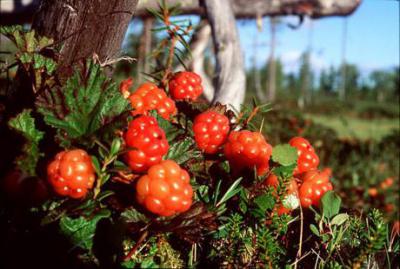

Also, the Kortkeros region of the republic is rich in "moss currants". One of the glades is located along the road to the village of Madzha.
On the right side of the Kortkeros - Veselovka road section, starting from the 9th kilometer, there are also cloudberry plantations. This territory was nicknamed Sobinovskie swamps. They are far from the track and occupy vast territories, so it will be difficult for an inexperienced berry-grower without a compass to navigate in them.
Experienced cloudberry gatherers say that when you come to the swamp, the berries are visible to the naked eye, and in good years they simply cannot be counted. For many, the collection of "moss currants" is one of the ways to earn money, and the berry goes not only to domestic, but also to foreign markets.
How to get to your destination?
How to get to the place? First by train to Tver, and then to Terelesovskaya station. The rest of the way will have to be done on foot: through the village we go into the forest, and then along the swamps to the lake. On the way, you may not meet cloudberries in the forest, but you can pick up plenty of blueberries and mushrooms.
You can also go for the "moss currant" by car. You need to get to Vyshny Volochok, from there to the village of Berezka, where you can rent a motor boat that will take you to your destination.
There is another travel option: not far from the village of Berezka, there is a recreation center where you can rent a room and stop the car.Here you can also collect a kayak (you should worry about this in advance) and go to the lake on your own.
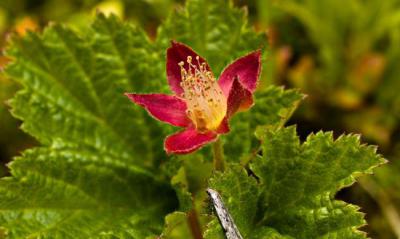

There are a lot of cloudberries on the banks of Metz in its wider part. Since it is far from the villages, there are not many people there, and cloudberries are called a dime a dozen. On the opposite bank from the village of Berezka, you can pitch a tent: it is better to take a boat or a kayak with you, so that you have the opportunity to look for “fruitful” meadows while swimming from coast to coast.
The nutritional value
Only 100 g of berries contain a large amount of nutrients:
- Proteins - 0.8 g
- Fat - 0.9 g
- Carbohydrates - 7.4 g
- Phosphorus - 28 mg
- Silicon - 0.05 mg
- Potassium - 180 mg
- Calcium - 15 mg
- Sodium - 1 mg
- Magnesium - 29 mg
- Aluminum - 280 mcg
- Iron - 0.7 mg
The calorie content of cloudberries is very low, only 40 kcal per 100 g. The berry is useful for losing weight, in addition to saturating the body with useful microelements, it has the ability to break down fats well.
BOLOTNY AMBER
In July and August, fruits appear - one at the top of each stem. Like raspberries, each "berry" of a cloudberry is actually a set of small fruits connected together. In each of them, juicy, fleshy pulp surrounds a hard bone. Such a structure is called a polystyrene. Cloudberry propagates both by seeds and vegetatively, using the shoots of rhizomes and creeping low shoots.
Collecting cloudberries is not easy. A rich harvest can be found only in the most inaccessible corners of the forest, where you have to wade through swamps and impassable thickets. Most often, it is in such places that you can find a whole orange carpet of ripe berries. Cloudberry lovers know that not quite ripe fruits can be picked. Reddish berries ripen in a few days, and they are much easier to store and transport than those that have already acquired an amber color.
Cloudberry for pregnant and lactating mothers
As you know, not all medicinal herbs have a beneficial effect on the body of the expectant mother. But pregnant women can not only take cloudberries, but also need them. The miracle berry has all the vitamins needed for the healthy development of the baby, the well-being of the mother and the facilitation of pregnancy.
Doctors advise taking the product 3 times a week. Cloudberry relieves dizziness and heartburn, is rich in vitamin E, which is useful for stimulating cell growth and renewal.
By the way, nursing mothers also need cloudberries. It contains simple sugar, easily absorbed by the body, many vitamins, which are so common during breastfeeding.
Well, if there is a desire to lose weight after childbirth, then fresh berries are an excellent assistant in this matter. If you are looking for weight, read the following articles:
Cloudberry is a valuable northern berry: benefits, contraindications and collection features
Cloudberry is a delicious orange-amber berry, known for its rich set of useful properties for a long time. In the photo it may seem that this is a small and very simple berry, but in fact it is a real storehouse of minerals, vitamins and other substances that are extremely valuable for human health. How did cloudberry deserve the title of the main northern berry? Does it have contraindications and what are they connected with? Next, we talk about the most important features of cloudberries and where they grow in Russia and when they need to be harvested.
Benefit
Based on such a rich composition, it is easy to assume that the medicinal properties of cloudberries are just as extensive. Many centuries ago, herbalists already knew and appreciated this berry, and also used it for healing. It has an excellent hemostatic and antispasmodic effect. For colds and viral diseases, this is an excellent natural immunostimulant that helps you quickly put yourself in order. The leaves have a strong healing and anti-inflammatory effect, and therefore they are recommended to be taken for urolithiasis and cystitis, bleeding and inflammatory processes.
We already wrote that the berry contains a lot of potassium. This allows you to effectively use it for hypertension and cardiovascular diseases. For the treatment of scurvy, it is no less effective than sauerkraut. Cloudberry leaves are indispensable in the elimination of skin diseases and inflammatory processes on the skin.It is used for the quick healing of injuries of any nature - from burns to festering wounds.
